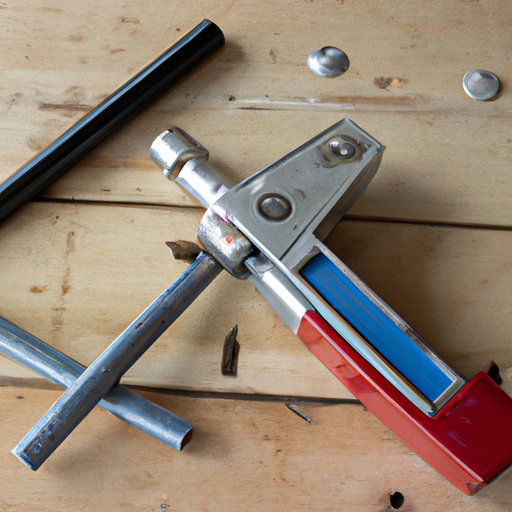
I. Introduction
When it comes to fastening materials together, a rivet gun is an essential tool to have. It is commonly used in manufacturing industries, including automotive, construction, and aviation. The goal of this article is to provide beginners with an in-depth guide on how to use a rivet gun. Readers will learn about different types of rivet guns, setting up their workspace, and safety precautions to take while using the tool. Additionally, readers will also be introduced to rivet fasteners, applications of rivets, and how to troubleshoot problems while using a rivet gun.
II. Basic introduction of rivet gun and its types
Rivet guns are handheld tools used to join two or more materials together, much like a stapler. The gun uses compressed air or a hydraulic system to forcefully drive the rivet through the materials and secure them. There are different types of rivet guns, including manual, pneumatic, cordless, and hydraulic.
It’s essential to choose the right rivet gun, depending on the intended application. For example, a handheld manual gun would work fine if the materials to be joined are thin and lightweight. In contrast, a pneumatic gun is ideal for industrial applications.
III. Preparing the workspace
Before using the rivet gun, you must prepare your workspace. This includes selecting the right location and workspace, ensuring good ventilation, and cleaning the area. Position your workbench near an electrical outlet and ensure that it is well-lit.
Clean the area to remove any dirt or debris that may interfere with the tool’s operation. You should also ensure that the materials to be joined are correctly aligned and fit appropriately.
IV. Loading and operating the rivet gun
Loading a rivet gun is a straightforward process. Begin by selecting the appropriate size of rivet and place it into the gun’s nosepiece. Pull the gun’s handles apart to open the jaws. Place the rivet’s mandrel into the jaws and release the handle’s grip, securing the mandrel in place.
Once loaded, you’re ready to operate the rivet gun. Adjust the pressure settings as per the manufacturer’s instructions to suit the material you’re working with. Pull the trigger to initiate the gun, ensuring that it is placed perpendicular to the material surface.
Make sure to mark your guidelines before initiating the gun to ensure accuracy in placement. Also, ensure that each rivet has enough clearance for the gun to move freely and avoid contact with other structures.
V. Safety precautions
Safety is crucial when using a rivet gun. Protective gear such as safety glasses, earplugs, gloves must be worn. Before using the gun, ensure that it’s well lubricated to avoid jamming. Make sure the work area is well lit and ventilated, avoiding enclosed spaces.
Prevent the gun from misfiring by keeping your fingers away from the trigger until you’re ready to work. If there is a jam, turn off the gun and disconnect the air supply before clearing it.
VI. Types of Rivet Fasteners
Different rivet fasteners are available, each with its unique characteristics, material compatibility, and applications. Blind, solid, tubular, and hollow are among the commonly used rivet fasteners. The type of materials to be joined and the level of hold strength you require will dictate the kind of rivet fastener you should use.
VII. Common Applications of Rivets
Rivets have a wide application in various industries, including aviation, automotive, sheet metal work, and construction. They are used to fasten two or more materials together, such as metal, plastic, and wood, among others. Aviation and automotive industries use rivets to join metallic materials such as aluminum and titanium. Construction work utilizes blind rivets to hold structures and frames together.
VIII. Troubleshooting
Even with the best preparatory measures, issues may arise when using a rivet gun. Some common problems include misfiring, jammed rivets, and the gun not functioning correctly. Suppose you experience such difficulties. In that case, the first step is to turn off the gun and disconnect it from the air supply.
Check the gun’s manual regarding the type of cleaning and maintenance recommended. Regular cleaning and oiling are essential to keep the gun in good working condition. If you encounter problems that you cannot rectify, seek help from a professional.
IX. Conclusion
A rivet gun is an essential tool that every DIY enthusiast and experts should be familiar with. With the right preparation, safety precautions, and proper application techniques, riveting becomes easier than you ever imagined. By following the steps outlined in this article, beginners and experts alike can now fasten materials with ease and efficiency using a rivet gun.





